Literature Review: Social Support and PTSD Among Combat Veterans
VerifiedAdded on 2023/06/09
|9
|2297
|367
Literature Review
AI Summary
This literature review examines the critical relationship between social support and Posttraumatic Stress Disorder (PTSD) among both women and men combat veterans. The review synthesizes findings from multiple peer-reviewed articles and scholarly sources, including both quantitative and qualitative studies, to explore how social support impacts PTSD symptoms and recovery. The studies, conducted on veterans from various conflicts, investigate factors such as pre- and post-deployment support, unit cohesion, and the influence of adverse life events. The review highlights the importance of social networks, emotional support, and timely interventions in mitigating the effects of trauma and improving the mental health outcomes of veterans. The studies also emphasize the need for increased awareness and resources to support veterans dealing with PTSD and related challenges, including suicidal ideation and depression.
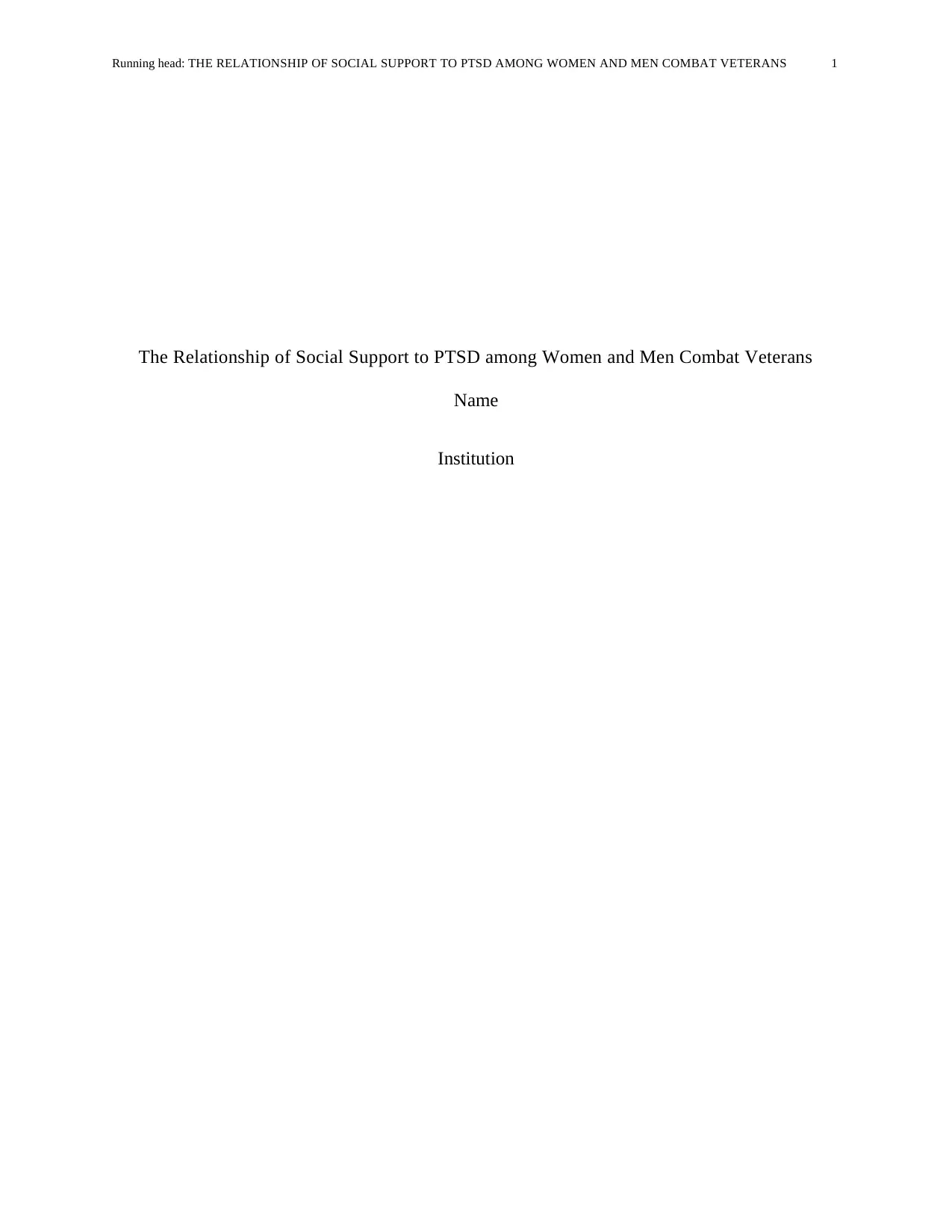
Running head: THE RELATIONSHIP OF SOCIAL SUPPORT TO PTSD AMONG WOMEN AND MEN COMBAT VETERANS 1
The Relationship of Social Support to PTSD among Women and Men Combat Veterans
Name
Institution
The Relationship of Social Support to PTSD among Women and Men Combat Veterans
Name
Institution
Paraphrase This Document
Need a fresh take? Get an instant paraphrase of this document with our AI Paraphraser
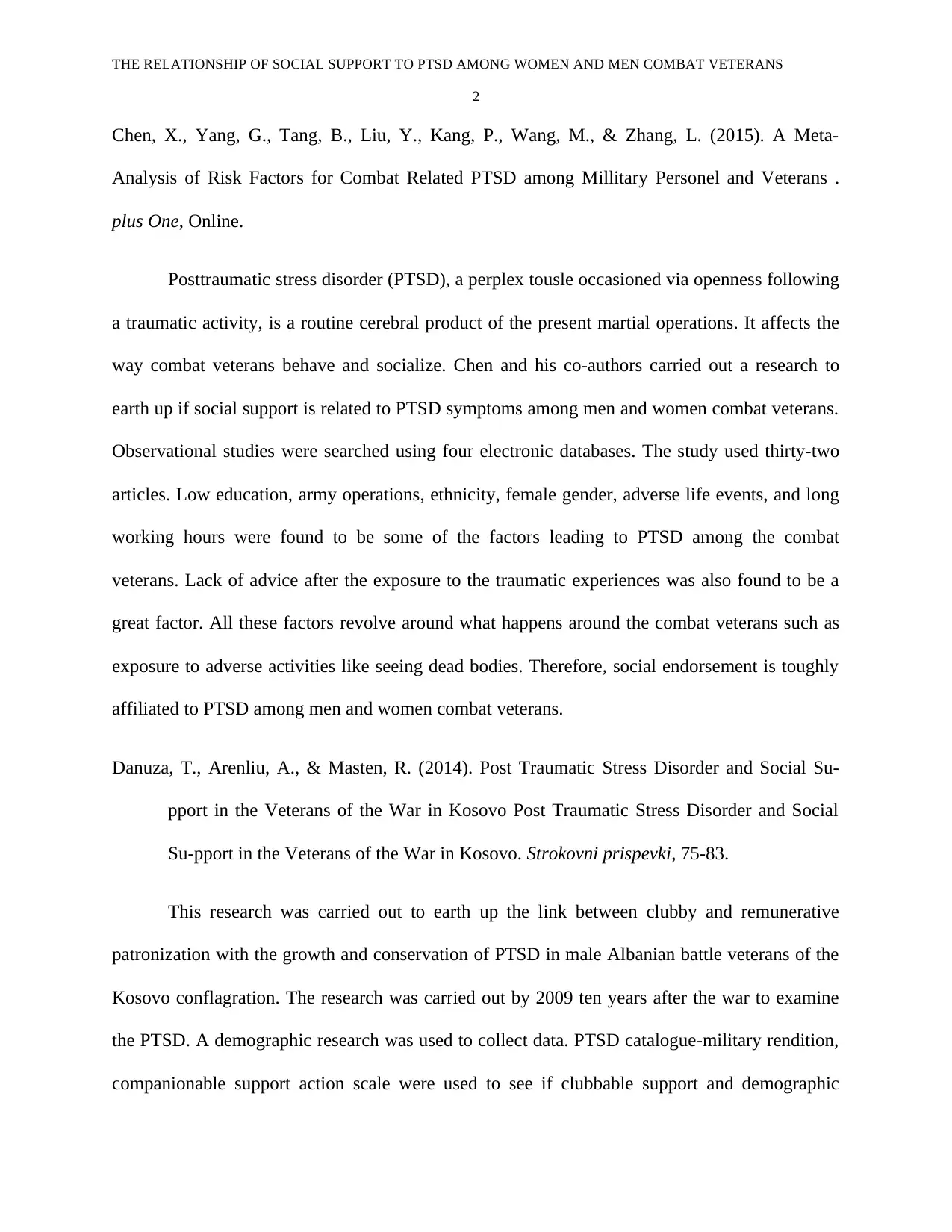
THE RELATIONSHIP OF SOCIAL SUPPORT TO PTSD AMONG WOMEN AND MEN COMBAT VETERANS
2
Chen, X., Yang, G., Tang, B., Liu, Y., Kang, P., Wang, M., & Zhang, L. (2015). A Meta-
Analysis of Risk Factors for Combat Related PTSD among Millitary Personel and Veterans .
plus One, Online.
Posttraumatic stress disorder (PTSD), a perplex tousle occasioned via openness following
a traumatic activity, is a routine cerebral product of the present martial operations. It affects the
way combat veterans behave and socialize. Chen and his co-authors carried out a research to
earth up if social support is related to PTSD symptoms among men and women combat veterans.
Observational studies were searched using four electronic databases. The study used thirty-two
articles. Low education, army operations, ethnicity, female gender, adverse life events, and long
working hours were found to be some of the factors leading to PTSD among the combat
veterans. Lack of advice after the exposure to the traumatic experiences was also found to be a
great factor. All these factors revolve around what happens around the combat veterans such as
exposure to adverse activities like seeing dead bodies. Therefore, social endorsement is toughly
affiliated to PTSD among men and women combat veterans.
Danuza, T., Arenliu, A., & Masten, R. (2014). Post Traumatic Stress Disorder and Social Su-
pport in the Veterans of the War in Kosovo Post Traumatic Stress Disorder and Social
Su-pport in the Veterans of the War in Kosovo. Strokovni prispevki, 75-83.
This research was carried out to earth up the link between clubby and remunerative
patronization with the growth and conservation of PTSD in male Albanian battle veterans of the
Kosovo conflagration. The research was carried out by 2009 ten years after the war to examine
the PTSD. A demographic research was used to collect data. PTSD catalogue-military rendition,
companionable support action scale were used to see if clubbable support and demographic
2
Chen, X., Yang, G., Tang, B., Liu, Y., Kang, P., Wang, M., & Zhang, L. (2015). A Meta-
Analysis of Risk Factors for Combat Related PTSD among Millitary Personel and Veterans .
plus One, Online.
Posttraumatic stress disorder (PTSD), a perplex tousle occasioned via openness following
a traumatic activity, is a routine cerebral product of the present martial operations. It affects the
way combat veterans behave and socialize. Chen and his co-authors carried out a research to
earth up if social support is related to PTSD symptoms among men and women combat veterans.
Observational studies were searched using four electronic databases. The study used thirty-two
articles. Low education, army operations, ethnicity, female gender, adverse life events, and long
working hours were found to be some of the factors leading to PTSD among the combat
veterans. Lack of advice after the exposure to the traumatic experiences was also found to be a
great factor. All these factors revolve around what happens around the combat veterans such as
exposure to adverse activities like seeing dead bodies. Therefore, social endorsement is toughly
affiliated to PTSD among men and women combat veterans.
Danuza, T., Arenliu, A., & Masten, R. (2014). Post Traumatic Stress Disorder and Social Su-
pport in the Veterans of the War in Kosovo Post Traumatic Stress Disorder and Social
Su-pport in the Veterans of the War in Kosovo. Strokovni prispevki, 75-83.
This research was carried out to earth up the link between clubby and remunerative
patronization with the growth and conservation of PTSD in male Albanian battle veterans of the
Kosovo conflagration. The research was carried out by 2009 ten years after the war to examine
the PTSD. A demographic research was used to collect data. PTSD catalogue-military rendition,
companionable support action scale were used to see if clubbable support and demographic
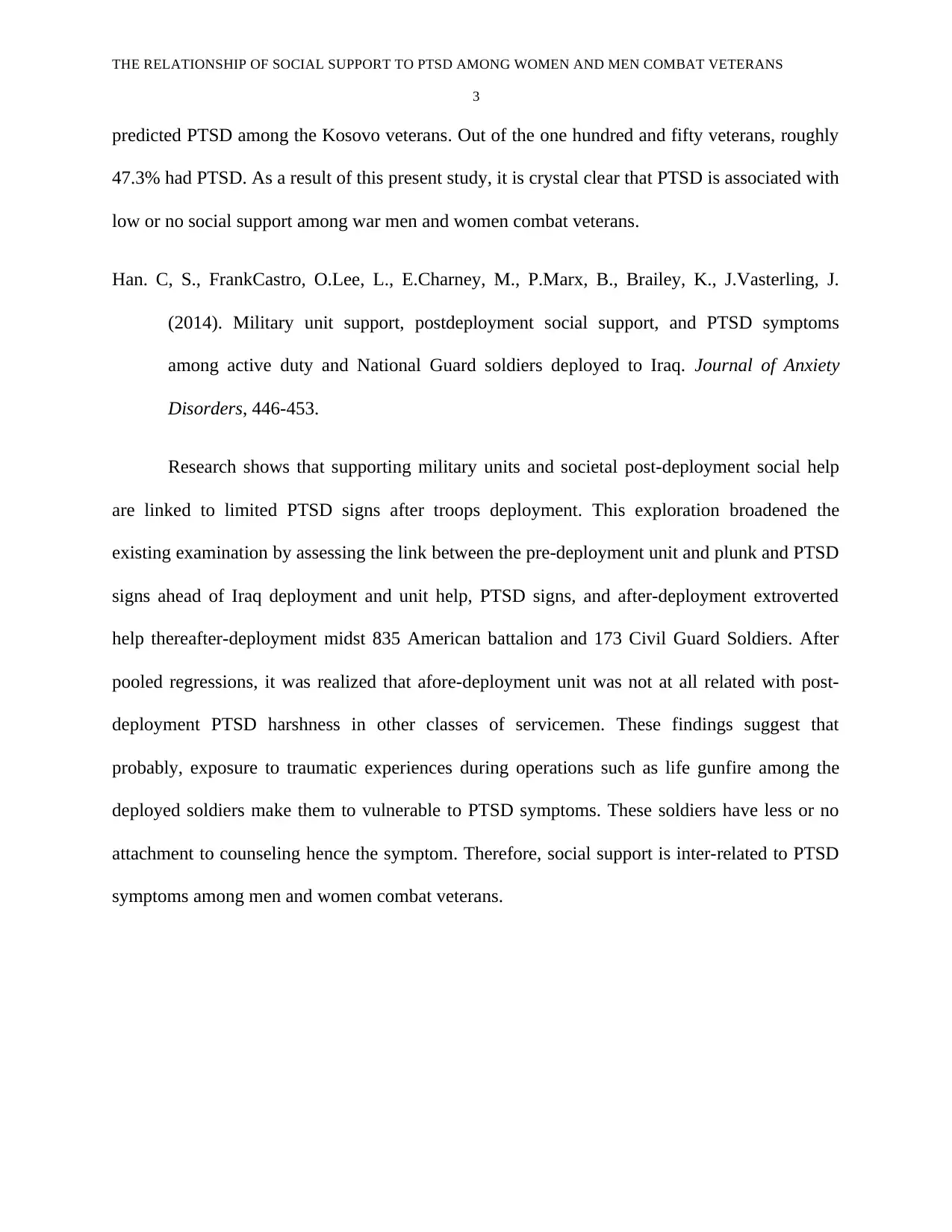
THE RELATIONSHIP OF SOCIAL SUPPORT TO PTSD AMONG WOMEN AND MEN COMBAT VETERANS
3
predicted PTSD among the Kosovo veterans. Out of the one hundred and fifty veterans, roughly
47.3% had PTSD. As a result of this present study, it is crystal clear that PTSD is associated with
low or no social support among war men and women combat veterans.
Han. C, S., FrankCastro, O.Lee, L., E.Charney, M., P.Marx, B., Brailey, K., J.Vasterling, J.
(2014). Military unit support, postdeployment social support, and PTSD symptoms
among active duty and National Guard soldiers deployed to Iraq. Journal of Anxiety
Disorders, 446-453.
Research shows that supporting military units and societal post-deployment social help
are linked to limited PTSD signs after troops deployment. This exploration broadened the
existing examination by assessing the link between the pre-deployment unit and plunk and PTSD
signs ahead of Iraq deployment and unit help, PTSD signs, and after-deployment extroverted
help thereafter-deployment midst 835 American battalion and 173 Civil Guard Soldiers. After
pooled regressions, it was realized that afore-deployment unit was not at all related with post-
deployment PTSD harshness in other classes of servicemen. These findings suggest that
probably, exposure to traumatic experiences during operations such as life gunfire among the
deployed soldiers make them to vulnerable to PTSD symptoms. These soldiers have less or no
attachment to counseling hence the symptom. Therefore, social support is inter-related to PTSD
symptoms among men and women combat veterans.
3
predicted PTSD among the Kosovo veterans. Out of the one hundred and fifty veterans, roughly
47.3% had PTSD. As a result of this present study, it is crystal clear that PTSD is associated with
low or no social support among war men and women combat veterans.
Han. C, S., FrankCastro, O.Lee, L., E.Charney, M., P.Marx, B., Brailey, K., J.Vasterling, J.
(2014). Military unit support, postdeployment social support, and PTSD symptoms
among active duty and National Guard soldiers deployed to Iraq. Journal of Anxiety
Disorders, 446-453.
Research shows that supporting military units and societal post-deployment social help
are linked to limited PTSD signs after troops deployment. This exploration broadened the
existing examination by assessing the link between the pre-deployment unit and plunk and PTSD
signs ahead of Iraq deployment and unit help, PTSD signs, and after-deployment extroverted
help thereafter-deployment midst 835 American battalion and 173 Civil Guard Soldiers. After
pooled regressions, it was realized that afore-deployment unit was not at all related with post-
deployment PTSD harshness in other classes of servicemen. These findings suggest that
probably, exposure to traumatic experiences during operations such as life gunfire among the
deployed soldiers make them to vulnerable to PTSD symptoms. These soldiers have less or no
attachment to counseling hence the symptom. Therefore, social support is inter-related to PTSD
symptoms among men and women combat veterans.
⊘ This is a preview!⊘
Do you want full access?
Subscribe today to unlock all pages.

Trusted by 1+ million students worldwide
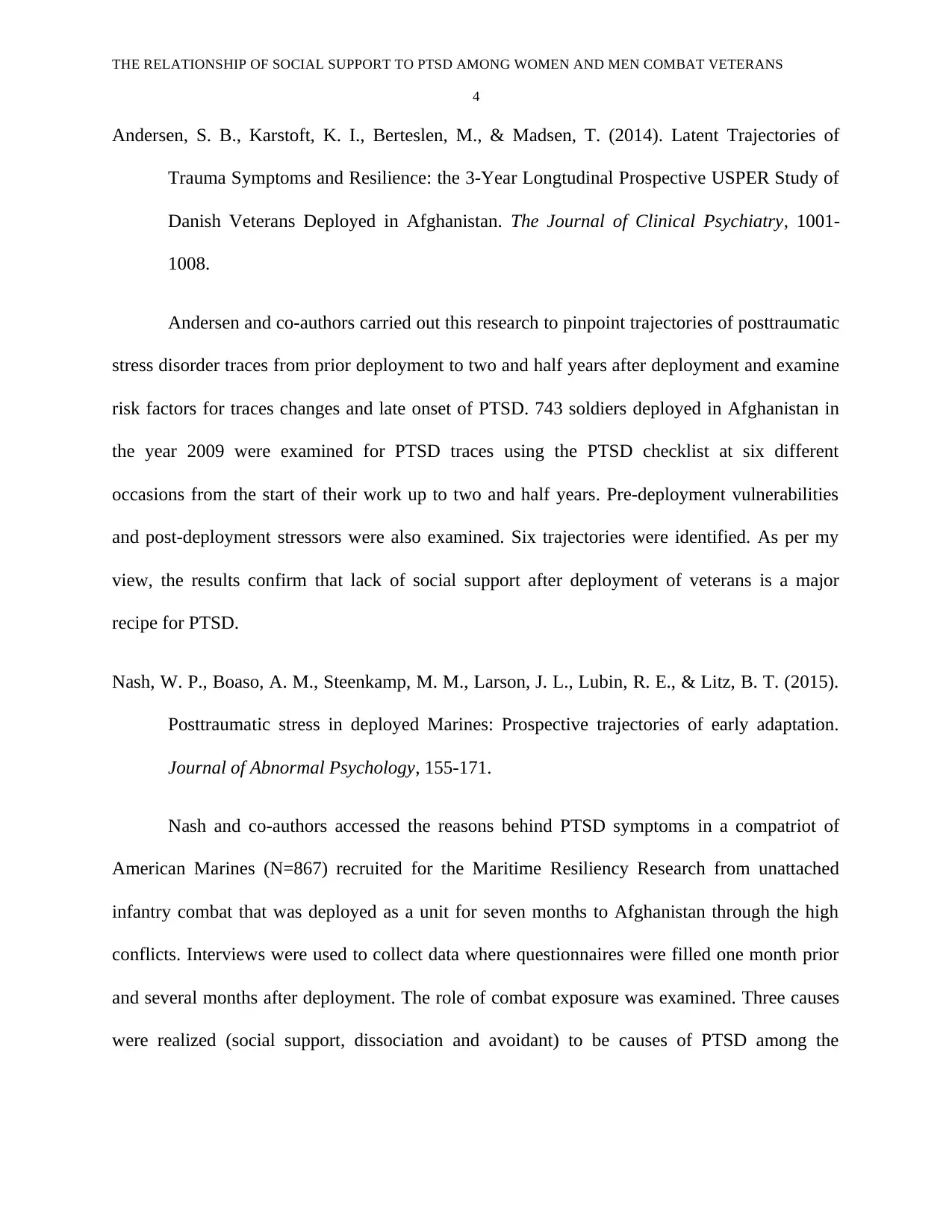
THE RELATIONSHIP OF SOCIAL SUPPORT TO PTSD AMONG WOMEN AND MEN COMBAT VETERANS
4
Andersen, S. B., Karstoft, K. I., Berteslen, M., & Madsen, T. (2014). Latent Trajectories of
Trauma Symptoms and Resilience: the 3-Year Longtudinal Prospective USPER Study of
Danish Veterans Deployed in Afghanistan. The Journal of Clinical Psychiatry, 1001-
1008.
Andersen and co-authors carried out this research to pinpoint trajectories of posttraumatic
stress disorder traces from prior deployment to two and half years after deployment and examine
risk factors for traces changes and late onset of PTSD. 743 soldiers deployed in Afghanistan in
the year 2009 were examined for PTSD traces using the PTSD checklist at six different
occasions from the start of their work up to two and half years. Pre-deployment vulnerabilities
and post-deployment stressors were also examined. Six trajectories were identified. As per my
view, the results confirm that lack of social support after deployment of veterans is a major
recipe for PTSD.
Nash, W. P., Boaso, A. M., Steenkamp, M. M., Larson, J. L., Lubin, R. E., & Litz, B. T. (2015).
Posttraumatic stress in deployed Marines: Prospective trajectories of early adaptation.
Journal of Abnormal Psychology, 155-171.
Nash and co-authors accessed the reasons behind PTSD symptoms in a compatriot of
American Marines (N=867) recruited for the Maritime Resiliency Research from unattached
infantry combat that was deployed as a unit for seven months to Afghanistan through the high
conflicts. Interviews were used to collect data where questionnaires were filled one month prior
and several months after deployment. The role of combat exposure was examined. Three causes
were realized (social support, dissociation and avoidant) to be causes of PTSD among the
4
Andersen, S. B., Karstoft, K. I., Berteslen, M., & Madsen, T. (2014). Latent Trajectories of
Trauma Symptoms and Resilience: the 3-Year Longtudinal Prospective USPER Study of
Danish Veterans Deployed in Afghanistan. The Journal of Clinical Psychiatry, 1001-
1008.
Andersen and co-authors carried out this research to pinpoint trajectories of posttraumatic
stress disorder traces from prior deployment to two and half years after deployment and examine
risk factors for traces changes and late onset of PTSD. 743 soldiers deployed in Afghanistan in
the year 2009 were examined for PTSD traces using the PTSD checklist at six different
occasions from the start of their work up to two and half years. Pre-deployment vulnerabilities
and post-deployment stressors were also examined. Six trajectories were identified. As per my
view, the results confirm that lack of social support after deployment of veterans is a major
recipe for PTSD.
Nash, W. P., Boaso, A. M., Steenkamp, M. M., Larson, J. L., Lubin, R. E., & Litz, B. T. (2015).
Posttraumatic stress in deployed Marines: Prospective trajectories of early adaptation.
Journal of Abnormal Psychology, 155-171.
Nash and co-authors accessed the reasons behind PTSD symptoms in a compatriot of
American Marines (N=867) recruited for the Maritime Resiliency Research from unattached
infantry combat that was deployed as a unit for seven months to Afghanistan through the high
conflicts. Interviews were used to collect data where questionnaires were filled one month prior
and several months after deployment. The role of combat exposure was examined. Three causes
were realized (social support, dissociation and avoidant) to be causes of PTSD among the
Paraphrase This Document
Need a fresh take? Get an instant paraphrase of this document with our AI Paraphraser
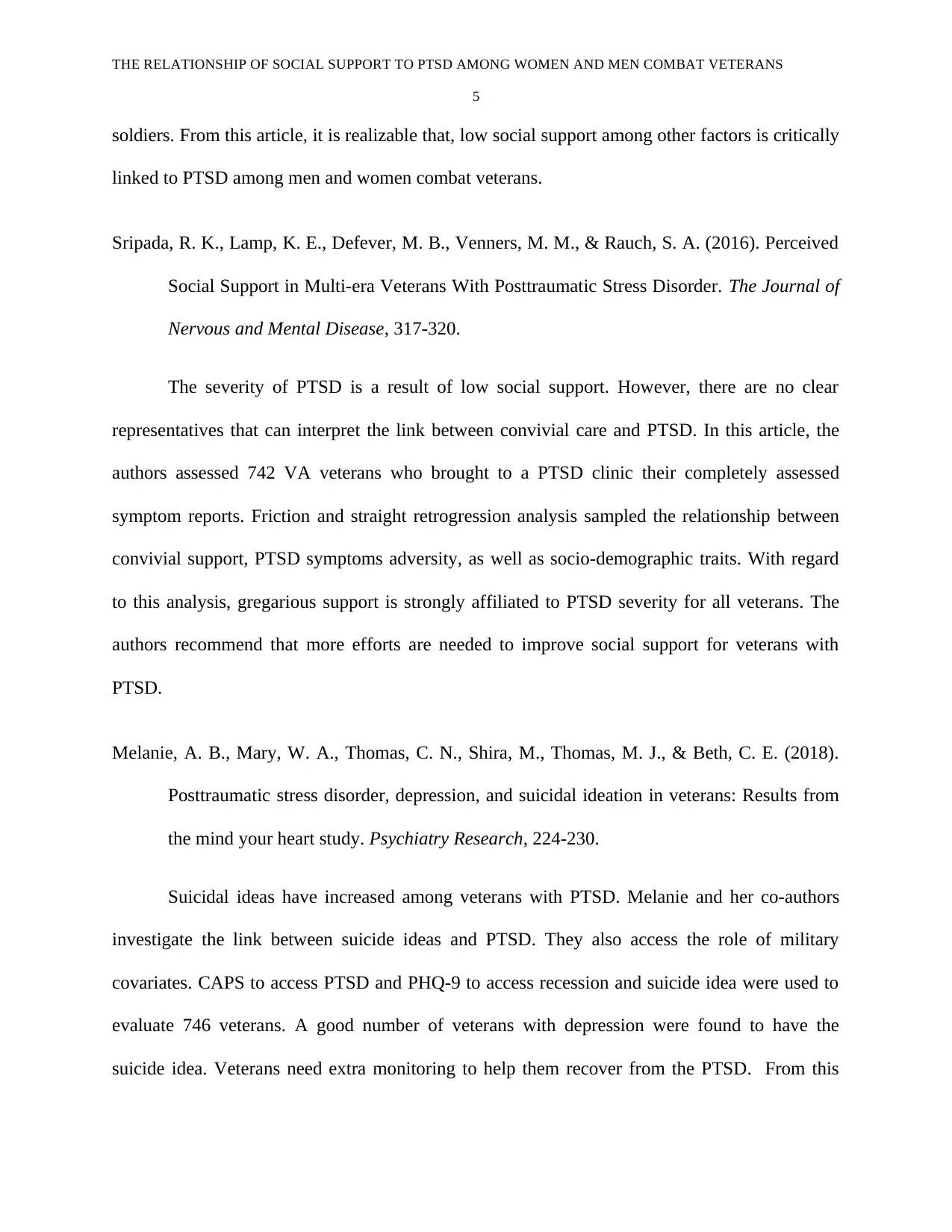
THE RELATIONSHIP OF SOCIAL SUPPORT TO PTSD AMONG WOMEN AND MEN COMBAT VETERANS
5
soldiers. From this article, it is realizable that, low social support among other factors is critically
linked to PTSD among men and women combat veterans.
Sripada, R. K., Lamp, K. E., Defever, M. B., Venners, M. M., & Rauch, S. A. (2016). Perceived
Social Support in Multi-era Veterans With Posttraumatic Stress Disorder. The Journal of
Nervous and Mental Disease, 317-320.
The severity of PTSD is a result of low social support. However, there are no clear
representatives that can interpret the link between convivial care and PTSD. In this article, the
authors assessed 742 VA veterans who brought to a PTSD clinic their completely assessed
symptom reports. Friction and straight retrogression analysis sampled the relationship between
convivial support, PTSD symptoms adversity, as well as socio-demographic traits. With regard
to this analysis, gregarious support is strongly affiliated to PTSD severity for all veterans. The
authors recommend that more efforts are needed to improve social support for veterans with
PTSD.
Melanie, A. B., Mary, W. A., Thomas, C. N., Shira, M., Thomas, M. J., & Beth, C. E. (2018).
Posttraumatic stress disorder, depression, and suicidal ideation in veterans: Results from
the mind your heart study. Psychiatry Research, 224-230.
Suicidal ideas have increased among veterans with PTSD. Melanie and her co-authors
investigate the link between suicide ideas and PTSD. They also access the role of military
covariates. CAPS to access PTSD and PHQ-9 to access recession and suicide idea were used to
evaluate 746 veterans. A good number of veterans with depression were found to have the
suicide idea. Veterans need extra monitoring to help them recover from the PTSD. From this
5
soldiers. From this article, it is realizable that, low social support among other factors is critically
linked to PTSD among men and women combat veterans.
Sripada, R. K., Lamp, K. E., Defever, M. B., Venners, M. M., & Rauch, S. A. (2016). Perceived
Social Support in Multi-era Veterans With Posttraumatic Stress Disorder. The Journal of
Nervous and Mental Disease, 317-320.
The severity of PTSD is a result of low social support. However, there are no clear
representatives that can interpret the link between convivial care and PTSD. In this article, the
authors assessed 742 VA veterans who brought to a PTSD clinic their completely assessed
symptom reports. Friction and straight retrogression analysis sampled the relationship between
convivial support, PTSD symptoms adversity, as well as socio-demographic traits. With regard
to this analysis, gregarious support is strongly affiliated to PTSD severity for all veterans. The
authors recommend that more efforts are needed to improve social support for veterans with
PTSD.
Melanie, A. B., Mary, W. A., Thomas, C. N., Shira, M., Thomas, M. J., & Beth, C. E. (2018).
Posttraumatic stress disorder, depression, and suicidal ideation in veterans: Results from
the mind your heart study. Psychiatry Research, 224-230.
Suicidal ideas have increased among veterans with PTSD. Melanie and her co-authors
investigate the link between suicide ideas and PTSD. They also access the role of military
covariates. CAPS to access PTSD and PHQ-9 to access recession and suicide idea were used to
evaluate 746 veterans. A good number of veterans with depression were found to have the
suicide idea. Veterans need extra monitoring to help them recover from the PTSD. From this
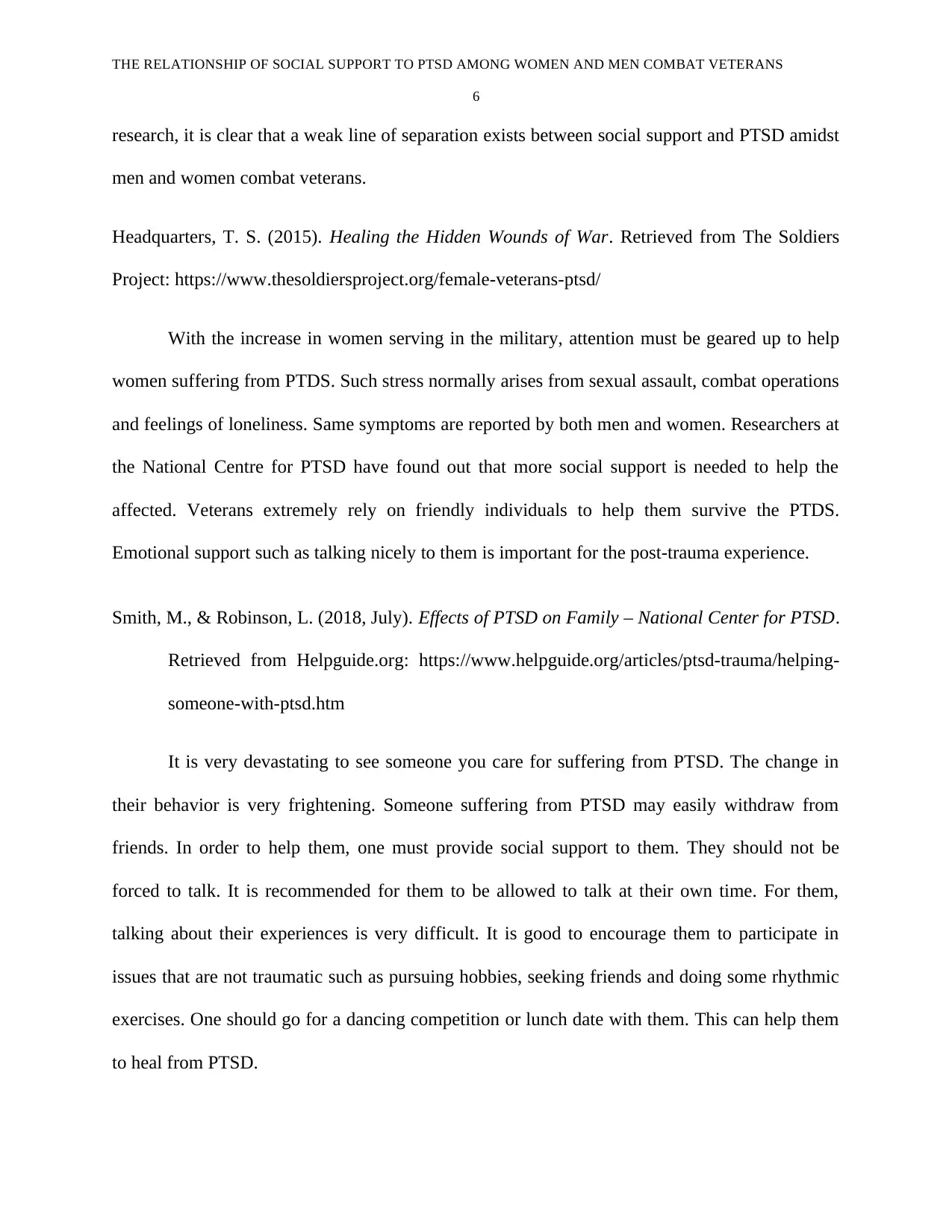
THE RELATIONSHIP OF SOCIAL SUPPORT TO PTSD AMONG WOMEN AND MEN COMBAT VETERANS
6
research, it is clear that a weak line of separation exists between social support and PTSD amidst
men and women combat veterans.
Headquarters, T. S. (2015). Healing the Hidden Wounds of War. Retrieved from The Soldiers
Project: https://www.thesoldiersproject.org/female-veterans-ptsd/
With the increase in women serving in the military, attention must be geared up to help
women suffering from PTDS. Such stress normally arises from sexual assault, combat operations
and feelings of loneliness. Same symptoms are reported by both men and women. Researchers at
the National Centre for PTSD have found out that more social support is needed to help the
affected. Veterans extremely rely on friendly individuals to help them survive the PTDS.
Emotional support such as talking nicely to them is important for the post-trauma experience.
Smith, M., & Robinson, L. (2018, July). Effects of PTSD on Family – National Center for PTSD.
Retrieved from Helpguide.org: https://www.helpguide.org/articles/ptsd-trauma/helping-
someone-with-ptsd.htm
It is very devastating to see someone you care for suffering from PTSD. The change in
their behavior is very frightening. Someone suffering from PTSD may easily withdraw from
friends. In order to help them, one must provide social support to them. They should not be
forced to talk. It is recommended for them to be allowed to talk at their own time. For them,
talking about their experiences is very difficult. It is good to encourage them to participate in
issues that are not traumatic such as pursuing hobbies, seeking friends and doing some rhythmic
exercises. One should go for a dancing competition or lunch date with them. This can help them
to heal from PTSD.
6
research, it is clear that a weak line of separation exists between social support and PTSD amidst
men and women combat veterans.
Headquarters, T. S. (2015). Healing the Hidden Wounds of War. Retrieved from The Soldiers
Project: https://www.thesoldiersproject.org/female-veterans-ptsd/
With the increase in women serving in the military, attention must be geared up to help
women suffering from PTDS. Such stress normally arises from sexual assault, combat operations
and feelings of loneliness. Same symptoms are reported by both men and women. Researchers at
the National Centre for PTSD have found out that more social support is needed to help the
affected. Veterans extremely rely on friendly individuals to help them survive the PTDS.
Emotional support such as talking nicely to them is important for the post-trauma experience.
Smith, M., & Robinson, L. (2018, July). Effects of PTSD on Family – National Center for PTSD.
Retrieved from Helpguide.org: https://www.helpguide.org/articles/ptsd-trauma/helping-
someone-with-ptsd.htm
It is very devastating to see someone you care for suffering from PTSD. The change in
their behavior is very frightening. Someone suffering from PTSD may easily withdraw from
friends. In order to help them, one must provide social support to them. They should not be
forced to talk. It is recommended for them to be allowed to talk at their own time. For them,
talking about their experiences is very difficult. It is good to encourage them to participate in
issues that are not traumatic such as pursuing hobbies, seeking friends and doing some rhythmic
exercises. One should go for a dancing competition or lunch date with them. This can help them
to heal from PTSD.
⊘ This is a preview!⊘
Do you want full access?
Subscribe today to unlock all pages.

Trusted by 1+ million students worldwide
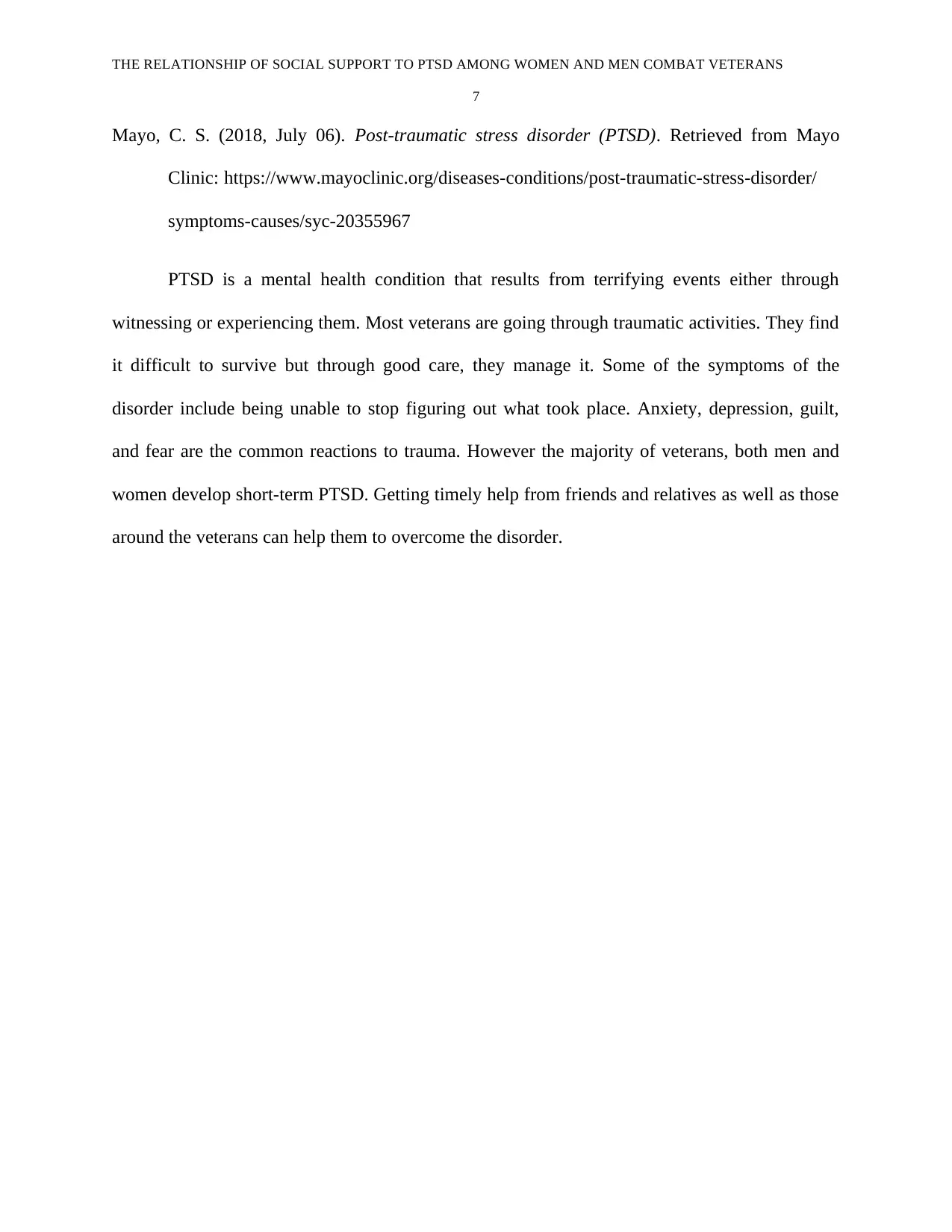
THE RELATIONSHIP OF SOCIAL SUPPORT TO PTSD AMONG WOMEN AND MEN COMBAT VETERANS
7
Mayo, C. S. (2018, July 06). Post-traumatic stress disorder (PTSD). Retrieved from Mayo
Clinic: https://www.mayoclinic.org/diseases-conditions/post-traumatic-stress-disorder/
symptoms-causes/syc-20355967
PTSD is a mental health condition that results from terrifying events either through
witnessing or experiencing them. Most veterans are going through traumatic activities. They find
it difficult to survive but through good care, they manage it. Some of the symptoms of the
disorder include being unable to stop figuring out what took place. Anxiety, depression, guilt,
and fear are the common reactions to trauma. However the majority of veterans, both men and
women develop short-term PTSD. Getting timely help from friends and relatives as well as those
around the veterans can help them to overcome the disorder.
7
Mayo, C. S. (2018, July 06). Post-traumatic stress disorder (PTSD). Retrieved from Mayo
Clinic: https://www.mayoclinic.org/diseases-conditions/post-traumatic-stress-disorder/
symptoms-causes/syc-20355967
PTSD is a mental health condition that results from terrifying events either through
witnessing or experiencing them. Most veterans are going through traumatic activities. They find
it difficult to survive but through good care, they manage it. Some of the symptoms of the
disorder include being unable to stop figuring out what took place. Anxiety, depression, guilt,
and fear are the common reactions to trauma. However the majority of veterans, both men and
women develop short-term PTSD. Getting timely help from friends and relatives as well as those
around the veterans can help them to overcome the disorder.
Paraphrase This Document
Need a fresh take? Get an instant paraphrase of this document with our AI Paraphraser
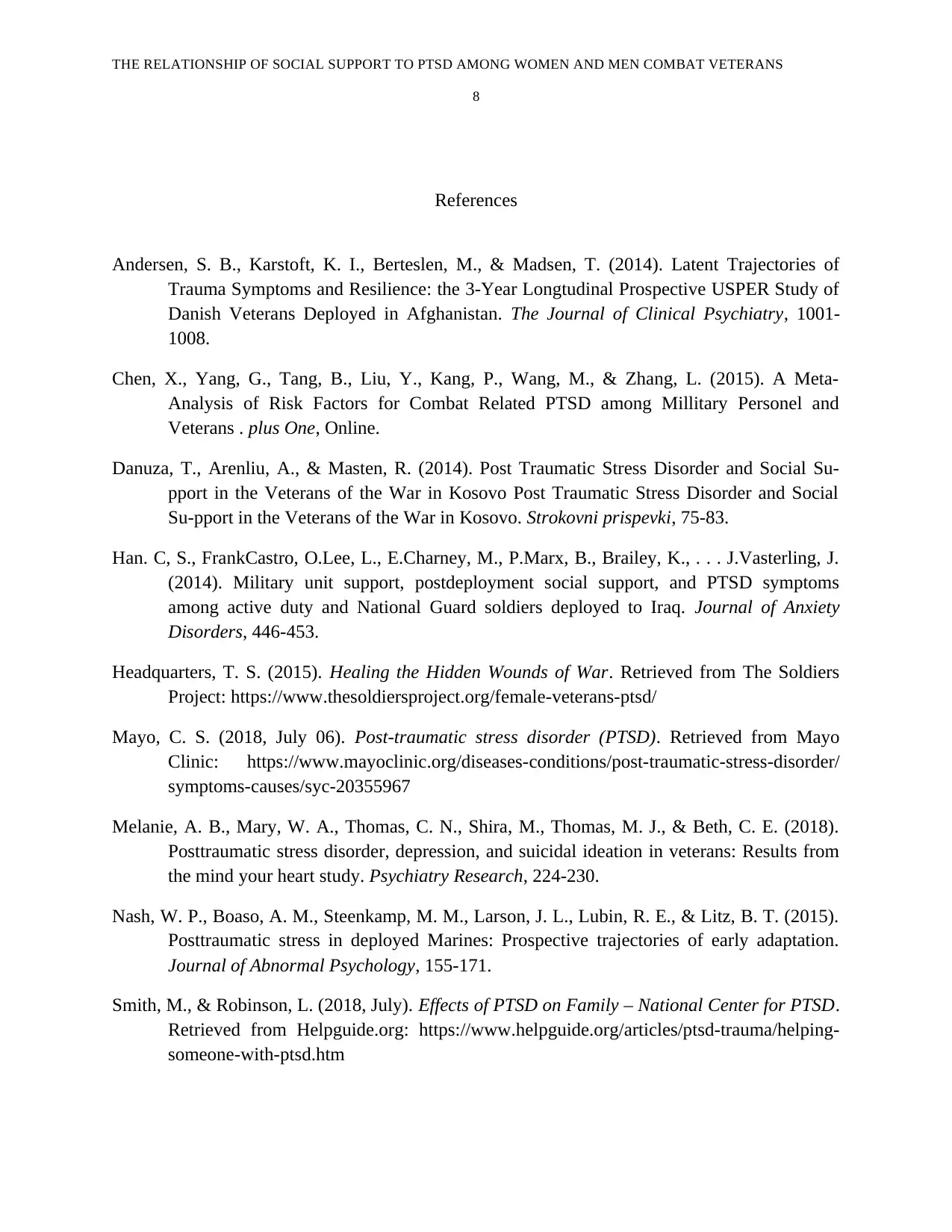
THE RELATIONSHIP OF SOCIAL SUPPORT TO PTSD AMONG WOMEN AND MEN COMBAT VETERANS
8
References
Andersen, S. B., Karstoft, K. I., Berteslen, M., & Madsen, T. (2014). Latent Trajectories of
Trauma Symptoms and Resilience: the 3-Year Longtudinal Prospective USPER Study of
Danish Veterans Deployed in Afghanistan. The Journal of Clinical Psychiatry, 1001-
1008.
Chen, X., Yang, G., Tang, B., Liu, Y., Kang, P., Wang, M., & Zhang, L. (2015). A Meta-
Analysis of Risk Factors for Combat Related PTSD among Millitary Personel and
Veterans . plus One, Online.
Danuza, T., Arenliu, A., & Masten, R. (2014). Post Traumatic Stress Disorder and Social Su-
pport in the Veterans of the War in Kosovo Post Traumatic Stress Disorder and Social
Su-pport in the Veterans of the War in Kosovo. Strokovni prispevki, 75-83.
Han. C, S., FrankCastro, O.Lee, L., E.Charney, M., P.Marx, B., Brailey, K., . . . J.Vasterling, J.
(2014). Military unit support, postdeployment social support, and PTSD symptoms
among active duty and National Guard soldiers deployed to Iraq. Journal of Anxiety
Disorders, 446-453.
Headquarters, T. S. (2015). Healing the Hidden Wounds of War. Retrieved from The Soldiers
Project: https://www.thesoldiersproject.org/female-veterans-ptsd/
Mayo, C. S. (2018, July 06). Post-traumatic stress disorder (PTSD). Retrieved from Mayo
Clinic: https://www.mayoclinic.org/diseases-conditions/post-traumatic-stress-disorder/
symptoms-causes/syc-20355967
Melanie, A. B., Mary, W. A., Thomas, C. N., Shira, M., Thomas, M. J., & Beth, C. E. (2018).
Posttraumatic stress disorder, depression, and suicidal ideation in veterans: Results from
the mind your heart study. Psychiatry Research, 224-230.
Nash, W. P., Boaso, A. M., Steenkamp, M. M., Larson, J. L., Lubin, R. E., & Litz, B. T. (2015).
Posttraumatic stress in deployed Marines: Prospective trajectories of early adaptation.
Journal of Abnormal Psychology, 155-171.
Smith, M., & Robinson, L. (2018, July). Effects of PTSD on Family – National Center for PTSD.
Retrieved from Helpguide.org: https://www.helpguide.org/articles/ptsd-trauma/helping-
someone-with-ptsd.htm
8
References
Andersen, S. B., Karstoft, K. I., Berteslen, M., & Madsen, T. (2014). Latent Trajectories of
Trauma Symptoms and Resilience: the 3-Year Longtudinal Prospective USPER Study of
Danish Veterans Deployed in Afghanistan. The Journal of Clinical Psychiatry, 1001-
1008.
Chen, X., Yang, G., Tang, B., Liu, Y., Kang, P., Wang, M., & Zhang, L. (2015). A Meta-
Analysis of Risk Factors for Combat Related PTSD among Millitary Personel and
Veterans . plus One, Online.
Danuza, T., Arenliu, A., & Masten, R. (2014). Post Traumatic Stress Disorder and Social Su-
pport in the Veterans of the War in Kosovo Post Traumatic Stress Disorder and Social
Su-pport in the Veterans of the War in Kosovo. Strokovni prispevki, 75-83.
Han. C, S., FrankCastro, O.Lee, L., E.Charney, M., P.Marx, B., Brailey, K., . . . J.Vasterling, J.
(2014). Military unit support, postdeployment social support, and PTSD symptoms
among active duty and National Guard soldiers deployed to Iraq. Journal of Anxiety
Disorders, 446-453.
Headquarters, T. S. (2015). Healing the Hidden Wounds of War. Retrieved from The Soldiers
Project: https://www.thesoldiersproject.org/female-veterans-ptsd/
Mayo, C. S. (2018, July 06). Post-traumatic stress disorder (PTSD). Retrieved from Mayo
Clinic: https://www.mayoclinic.org/diseases-conditions/post-traumatic-stress-disorder/
symptoms-causes/syc-20355967
Melanie, A. B., Mary, W. A., Thomas, C. N., Shira, M., Thomas, M. J., & Beth, C. E. (2018).
Posttraumatic stress disorder, depression, and suicidal ideation in veterans: Results from
the mind your heart study. Psychiatry Research, 224-230.
Nash, W. P., Boaso, A. M., Steenkamp, M. M., Larson, J. L., Lubin, R. E., & Litz, B. T. (2015).
Posttraumatic stress in deployed Marines: Prospective trajectories of early adaptation.
Journal of Abnormal Psychology, 155-171.
Smith, M., & Robinson, L. (2018, July). Effects of PTSD on Family – National Center for PTSD.
Retrieved from Helpguide.org: https://www.helpguide.org/articles/ptsd-trauma/helping-
someone-with-ptsd.htm

THE RELATIONSHIP OF SOCIAL SUPPORT TO PTSD AMONG WOMEN AND MEN COMBAT VETERANS
9
Sripada, R. K., Lamp, K. E., Defever, M. B., Venners, M. M., & Rauch, S. A. (2016). Perceived
Social Support in Multi-era Veterans With Posttraumatic Stress Disorder. The Journal of
Nervous and Mental Disease, 317-320.
9
Sripada, R. K., Lamp, K. E., Defever, M. B., Venners, M. M., & Rauch, S. A. (2016). Perceived
Social Support in Multi-era Veterans With Posttraumatic Stress Disorder. The Journal of
Nervous and Mental Disease, 317-320.
⊘ This is a preview!⊘
Do you want full access?
Subscribe today to unlock all pages.

Trusted by 1+ million students worldwide
1 out of 9
Related Documents
Your All-in-One AI-Powered Toolkit for Academic Success.
+13062052269
info@desklib.com
Available 24*7 on WhatsApp / Email
![[object Object]](/_next/static/media/star-bottom.7253800d.svg)
Unlock your academic potential
Copyright © 2020–2025 A2Z Services. All Rights Reserved. Developed and managed by ZUCOL.




